| Listing 1 - 10 of 30 | << page >> |
Sort by
|
Book
ISSN: 09241922 ISBN: 9789004194946 9789004245693 9004194940 Year: 2013 Volume: 74 Publisher: Leiden ;Boston Martinus Nijhoff PUblishers
Abstract | Keywords | Export | Availability | Bookmark
 Loading...
Loading...Choose an application
- Reference Manager
- EndNote
- RefWorks (Direct export to RefWorks)
Book
ISBN: 9781138388147 9780429758911 042975891X 9780429758928 0429758928 9780429425745 0429425740 9780429758904 0429758901 1138388149 Year: 2021 Publisher: London: New-York: Routledge,
Abstract | Keywords | Export | Availability | Bookmark
 Loading...
Loading...Choose an application
- Reference Manager
- EndNote
- RefWorks (Direct export to RefWorks)
There has been a recent increase in clashes between warships asserting rights to navigate and states asserting sovereignty over coastal waters. This book argues for a set of rules which respect the rights of coastal states to protect their sovereignty and of warships to navigate lawfully, whilst also outlining the limits of each. The book addresses the issue of the clash between warships and states by considering the general principles applying to use of force in the law of the sea and the law of national self-defence. It focuses on the right of coastal states to use force to prevent passage of warships which threaten their sovereignty, with particular reference to the specific maritime zones, as well as by warships to ensure passage or to defend themselves. The book also assesses the extent to which the law of armed conflict may be applicable to these issues. The conclusion draws together a set of rules which take account of both contemporary and historical events and seeks to balance the competing interests at stake. Providing a concise overview of the enduring issue of freedom of navigation, this book will appeal to anyone studying international law, the law of the sea, security studies and international relations. It will also be of interest to naval, coast guard and military officers as well as government legal advisors
Contiguous zones (Law of the sea). --- Freedom of the seas. --- Mare clausum. --- Maritime boundaries. --- Navigation. --- Self-defense (International law). --- War, Maritime (International law). --- Warships --- Law and legislation.
Book
ISBN: 881400885X 9788814008856 Year: 1986 Volume: 18 Publisher: Milano: Giuffrè,
Abstract | Keywords | Export | Availability | Bookmark
 Loading...
Loading...Choose an application
- Reference Manager
- EndNote
- RefWorks (Direct export to RefWorks)
Boundaries --- Territorial waters --- Contiguous zones (Maritime law) --- Continental shelf --- Treaties --- Frontières --- Traités --- Maps --- Cartes --- Contiguous zones (Law of the sea) --- Treaties. --- Maps. --- Frontières --- Traités --- Boundaries - Maps --- Territorial waters - Maps --- Contiguous zones (Law of the sea) - Maps --- Continental shelf - Maps
Book
ISBN: 9782233007889 2233007883 Year: 2016 Volume: 61 Publisher: Paris: Pedone,
Abstract | Keywords | Export | Availability | Bookmark
 Loading...
Loading...Choose an application
- Reference Manager
- EndNote
- RefWorks (Direct export to RefWorks)
La délimitation des frontières maritimes constitue un enjeu crucial pour un grand nombre d'États. Pourtant, la Convention des Nations Unies sur le droit de la mer de 1982 reste largement ambiguë, si ce n'est entièrement silencieuse, sur les méthodes précises à appliquer pour résoudre un différend frontalier maritime. Dans ce contexte, et face à une pratique étatique incohérente et dépourvue d'opinio juris, c'est principalement dans leur propre vision que les cours et tribunaux arbitraux internationaux ont progressivement puisé la règle de l'équidistance/circonstances pertinentes, en vertu de laquelle, en l'absence de raisons impérieuses, toute délimitation maritime décidée, quels que soient l'espace maritime et la configuration côtière considérés, débute par la construction d'une ligne d'équidistance provisoire. Cette ligne pourra éventuellement être ajustée par la suite pour tenir compte des circonstances particulières de chaque affaire, dans l'objectif de garantir un résultat équitable. En dépit de la consécration claire et unanime de la règle de l'équidistance/circonstances pertinentes dans l'affaire de la Délimitation maritime en mer Noire en 2009, les décisions postérieures soulèvent un certain nombre de doutes quant à son caractère contraignant. Indépendamment de ces considérations de nature théorique, de nombreuses zones d'ombre et difficultés pratiques persistent dans la mise en oeuvre de la règle de l'équidistance/circonstances pertinentes, notamment en ce qui concerne le risque d'une part trop importante de subjectivité - voire d'arbitraire - dans le choix de méthodes alternatives de délimitation, la fixation des points de base, le degré d'ajustement d'une ligne d'équidistance provisoire et le rôle joué par la proportionnalité. De même, alors que la « matérialisation " d'une frontière maritime décidée sur le terrain " nécessite une collaboration étroite entre d'une part le juriste et, d'autre part, le cartographe, l'hydrographe et le géographe, un nombre trop important de décisions présente encore des carences de nature pratique. Loin donc d'être abouti, le droit de la délimitation maritime appelle à des consolidations et précisions futures importantes.
Territorial waters --- Contiguous zones (Law of the sea) --- Boundary disputes --- Conflict of laws --- Law of the sea --- Eaux territoriales --- Zone contiguë --- Conflits de frontières --- Droit maritime (Droit international privé) --- Droit de la mer --- Maritime law --- Zone contiguë --- Conflits de frontières --- Droit maritime (Droit international privé)

ISBN: 9024732506 9789024732500 Year: 1986 Publisher: Dordrecht Nijhoff
Abstract | Keywords | Export | Availability | Bookmark
 Loading...
Loading...Choose an application
- Reference Manager
- EndNote
- RefWorks (Direct export to RefWorks)
Economic zones (Law of the sea) --- 341.2 --- Economic zones (Maritime law) --- Exclusive economic zones (Law of the sea) --- Patrimonial sea (Law of the sea) --- Law of the sea --- Contiguous zones (Law of the sea) --- Territorial waters --- Subjecten en objecten in het volkenrecht --(algemeen) --- Economic zones (Law of the sea). --- 341.2 Subjecten en objecten in het volkenrecht --(algemeen)
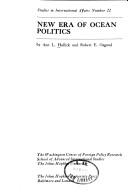
ISBN: 0801816343 9780801816345 Year: 1974 Volume: 22 Publisher: Baltimore (Md.): Johns Hopkins University press,
Abstract | Keywords | Export | Availability | Bookmark
 Loading...
Loading...Choose an application
- Reference Manager
- EndNote
- RefWorks (Direct export to RefWorks)
#SBIB:327.6H01 --- Internationale en diplomatieke relaties: specifieke conflicten --- Marine resources --- Ocean bottom --- Territorial waters --- Limit, Three-mile (Territorial waters) --- Marginal sea (Territorial waters) --- Maritime belt (Territorial waters) --- Territorial sea --- Three-mile limit (Territorial waters) --- Bodies of water --- Jurisdiction, Territorial --- Territory, National --- Contiguous zones (Law of the sea) --- Continental shelf --- Economic zones (Law of the sea) --- Innocent passage (Law of the sea) --- Law of the sea --- Ocean bottom (Maritime law) --- Marine resources and state --- Government policy --- Law and legislation --- Marine policy
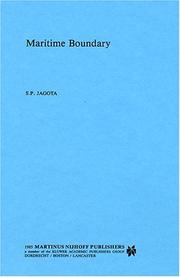
ISBN: 902473133X 9004478221 9789024731336 9789004478220 Year: 1985 Volume: 9 Publisher: Leiden;Boston Brill | Nijhoff
Abstract | Keywords | Export | Availability | Bookmark
 Loading...
Loading...Choose an application
- Reference Manager
- EndNote
- RefWorks (Direct export to RefWorks)
Economic zones (Law of the sea) --- Territorial waters --- Territorial waters. --- Economic zones (Law of the sea). --- Limit, Three-mile (Territorial waters) --- Marginal sea (Territorial waters) --- Maritime belt (Territorial waters) --- Territorial sea --- Three-mile limit (Territorial waters) --- Bodies of water --- Jurisdiction, Territorial --- Territory, National --- Contiguous zones (Law of the sea) --- Continental shelf --- Innocent passage (Law of the sea) --- Law of the sea --- Economic zones (Maritime law) --- Exclusive economic zones (Law of the sea) --- Patrimonial sea (Law of the sea)
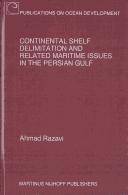
ISBN: 9789041103338 9789004479296 9041103333 Year: 1997 Volume: 29 Publisher: Leiden;Boston Brill | Nijhoff
Abstract | Keywords | Export | Availability | Bookmark
 Loading...
Loading...Choose an application
- Reference Manager
- EndNote
- RefWorks (Direct export to RefWorks)
The most significant characteristic of the Persian Gulf is the presence of huge oil-fields under the sea-bed of its shallow waters. On the other hand, the lack of understanding among the littoral states concerning the proper exploitation of these valuable resources has led to many conflicts, and is still considered as having a very high potential for conflict. This work clarifies the international legal rules applicable to the region with particular attention to the special characteristics of the Persian Gulf, such as ethnic conflicts, lack of defined land borders, presence of numerous islands, reefs and shoals and the presence of transboundary oil deposits. It consists of a collection of materials relating to the law of the sea, including both domestic and international rules, conventions, maritime agreements, state practice, the jurisprudence of the International Court of Justice and others. The study analyses all of these important factors in order to find an equitable solution to the problems facing the international community.
Continental shelf --- Ocean bottom --- Territorial waters --- Law and legislation --- Limit, Three-mile (Territorial waters) --- Marginal sea (Territorial waters) --- Maritime belt (Territorial waters) --- Territorial sea --- Three-mile limit (Territorial waters) --- Bodies of water --- Jurisdiction, Territorial --- Territory, National --- Contiguous zones (Law of the sea) --- Economic zones (Law of the sea) --- Innocent passage (Law of the sea) --- Law of the sea --- Bottom of the ocean --- Floor of the ocean --- Ocean floor --- Sea bed --- Sea floor --- Seafloor --- Seabed --- Subsoil of the ocean floor --- Submarine topography --- Continental margins
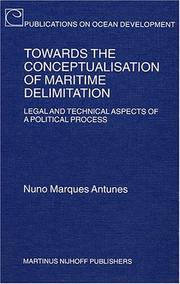
ISBN: 9789004482050 9789004136175 9004136177 Year: 2003 Publisher: Leiden;Boston Brill | Nijhoff
Abstract | Keywords | Export | Availability | Bookmark
 Loading...
Loading...Choose an application
- Reference Manager
- EndNote
- RefWorks (Direct export to RefWorks)
This new monograph on maritime delimitation by Dr. Nuno Antunes is based on a thesis submitted for the degree of Doctor of Philosophy at the University of Durham. The work is one of legal, political and technical analysis of an aspect of the law of the sea that is of current interest in all regions of the world.
Delimitation --- maritime boundaries --- Technic --- Territorial sea --- Boundaries --- Territorial waters --- Maritime boundaries --- Limit, Three-mile (Territorial waters) --- Marginal sea (Territorial waters) --- Maritime belt (Territorial waters) --- Three-mile limit (Territorial waters) --- Bodies of water --- Jurisdiction, Territorial --- Territory, National --- Contiguous zones (Law of the sea) --- Continental shelf --- Economic zones (Law of the sea) --- Innocent passage (Law of the sea) --- Law of the sea --- Borders (Geography) --- Boundary lines --- Frontiers --- Geographical boundaries --- International boundaries --- Lines, Boundary --- Natural boundaries --- Perimeters (Boundaries) --- Political boundaries --- Borderlands
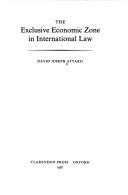
ISBN: 0198255411 9780198255413 Year: 1987 Publisher: Oxford: Clarendon,
Abstract | Keywords | Export | Availability | Bookmark
 Loading...
Loading...Choose an application
- Reference Manager
- EndNote
- RefWorks (Direct export to RefWorks)
Law of nations: objects and subjects --- Shipping law --- Economic zones (Law of the sea) --- Maritime law --- Zones économiques (Droit de la mer) --- Droit maritime --- Law of the sea --- 341.225 --- High seas, Jurisdiction over --- Marine law --- Ocean --- Ocean law --- Sea, Law of the --- International law --- Territorial waters --- Economic zones (Maritime law) --- Exclusive economic zones (Law of the sea) --- Patrimonial sea (Law of the sea) --- Contiguous zones (Law of the sea) --- Internationaal zeerecht. Mare liberum. Vrije zee. Zeeengten --- Law and legislation --- Territorial watersInternationaal zeerecht. Mare liberum. Vrije zee. Zeeengten --- 341.225 Internationaal zeerecht. Mare liberum. Vrije zee. Zeeengten --- Zones économiques (Droit de la mer)
| Listing 1 - 10 of 30 | << page >> |
Sort by
|

 Search
Search Feedback
Feedback About UniCat
About UniCat  Help
Help News
News